
| ||||
|---|---|---|---|---|
 |
 |
 |
 |
 |



























| ||||
|---|---|---|---|---|
 |
 |
 |
 |
 |


























Boeing B-17G "Flying Fortress"
United States — USAAF II four-engined long-range heavy bomber
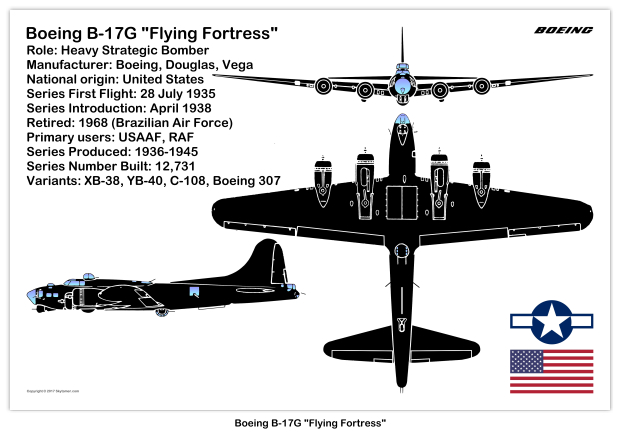
Archive Photos 1
Boeing B-17G-85-DL "Flying Fortress" "Sentimental Journey" (AF 44-83514) c.2000 at the Hawthorne Air Faire, Hawthorne, California (Photos by John Shupek)
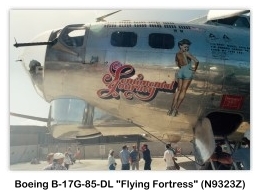
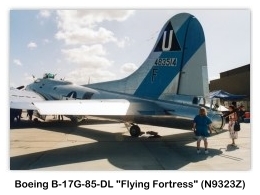
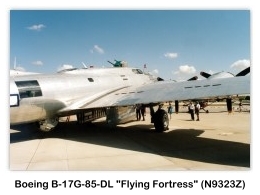


Boeing B-17G-85-DL "Flying Fortress" (AF 44-83546) at the Hawthorne Air Faire, Hawthorne, California (Photos by John Shupek)

Boeing B-17G "Flying Fortress" "Return to Glory" (AF 44-6393) at the March Field Air Museum, Riverside, California (Photos by John Shupek)









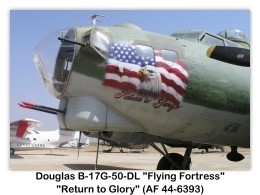
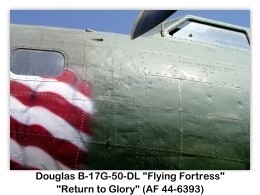

Boeing B-17G-90-DL "Flying Fortress" "Short Bier" (AF 44-83663) at the Hill Aerospace Museum, Hill Air Force Base, Salt Lake City, Utah (Photos by John Shupek)




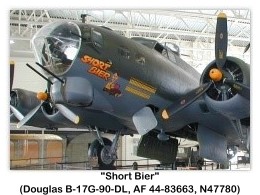
Boeing B-17G-110-VE "Flying Fortress" "Yankee Lady" (AF 44-85829) at the Yankee Air Museum, Belleville, Michigan (Photos by John Shupek)
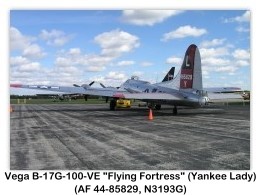

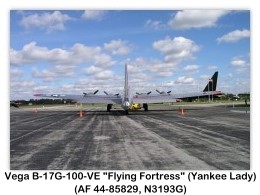






Boeing B-17G-90-DL "Flying Fortress" "Piccadilly Lilly II" (AF 44-83684) at the Planes of Fame Air Museum, Chino, California (Photos by John Shupek)



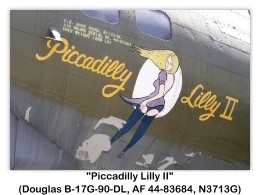
Boeing B-17G-85-DL "Flying Fortress" "Fuddy Duddy" (AF 44-83563) at Fox Field, Lancaster, California (Photos by John Shupek)


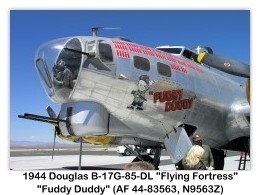

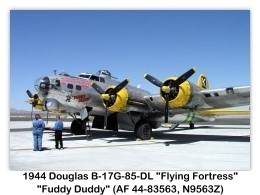
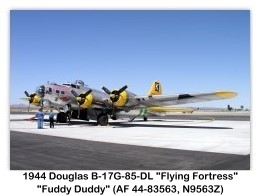

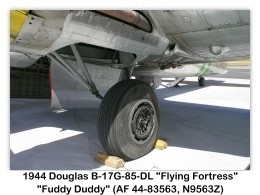
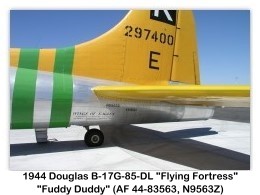



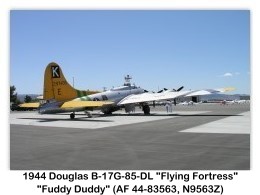



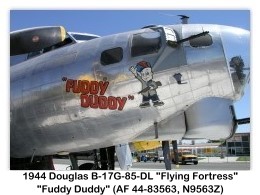

Boeing B-17G "Flying Fortress" "Chief Oshkosh" (Nose Art) at the EAA AirVenture Museum, Oshkosh, WI (Photos by John Shupek)
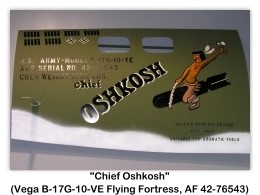
Boeing B-17G-85-DL "Flying Fortress" "Heavens Above" (nose art) (AF 44-83512) at the U. S. Air Force History and Traditions Museum, Lackland Air Force Base, Texas (Photos by John Shupek)
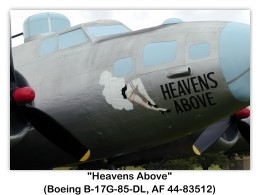
Boeing B-17G-105-VE "Flying Fortress" "Miss Angela" (nose art) (AF 44-85778) at the Palm Springs Air Museum, Palm Springs, California (Photos by John Shupek)

Boeing B-17G-85-DL "Flying Fortress" "Piccadilly Princess" (nose art) (AF 44-83542) at the Fantasy of Flight, Polk City, FL (Photos by John Shupek)
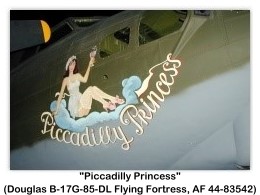
Boeing B-17G-90-BO "Flying Fortress" "Virgin’s Delight" (nose art) (AF 43-38635) at the Castle Air Museum, Atwater, California (Photos by John Shupek)
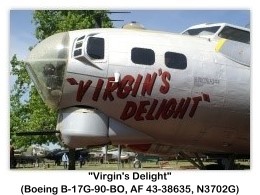
Boeing B-17G-35-VE "Flying Fortress" "Liberty Belle" (AF 42-97849) at the 2007 Aviation Nation, Nellis Air Force Base, Las Vegas, Nevada (Photos by John Shupek)


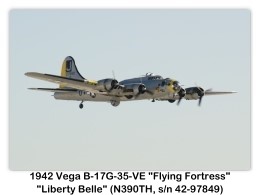
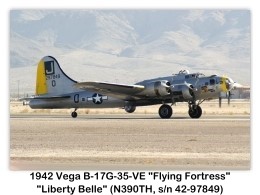

Overview 2
The Boeing B-17 "Flying Fortress" is a four-engine heavy bomber aircraft developed for the United States Army Air Corps (USAAC), introduced in the 1930s. Competing against Douglas and Martin for a contract to build 200 bombers, the Boeing entry outperformed both competitors and more than met the Air Corps’ expectations. Although Boeing lost the contract due to the prototype’s crash, the Air Corps was so impressed with Boeing’s design that they ordered 13 B-17s. The B-17 Flying Fortress went on to eventually evolve through numerous design advancements.
The B-17 was primarily employed by the United States Army Air Forces (USAAF) in the daylight precision strategic bombing campaign of World War II against German industrial, civilian, and military targets. The United States Eighth Air Force based in England and the Fifteenth Air Force based in Italy complemented the RAF Bomber Command’s nighttime area bombing in Operation Pointblank, to help secure air superiority over the cities, factories and battlefields of Western Europe in preparation for Operation Overlord. The B-17 also participated, to a lesser extent, in the War in the Pacific, where it conducted raids against Japanese shipping and airfields.
From its pre-war inception, the USAAC (later USAAF) touted the aircraft as a strategic weapon; it was a potent, high-flying, long-ranging bomber capable of unleashing great destruction, able to defend itself, and having the ability to return home despite extensive battle damage. It quickly took on mythic proportions. Stories and photos of B-17s surviving battle damage widely circulated, increasing its iconic status. Despite an inferior range and bombload compared to the more numerous B-24 Liberator, a survey of Eighth Air Force crews showed a much higher rate of satisfaction in the B-17. With a service ceiling greater than any of its Allied contemporaries, the B-17 established itself as a superb weapons system, dropping more bombs than any other U.S. aircraft in World War II. Of the 1.5 million tonnes of bombs dropped on Germany by U.S. aircraft, 640,000 were dropped from B-17s.
Design and Development 2
On 8 August 1934, the U.S. Army Air Corps (USAAC) tendered a proposal for a multi-engined bomber to replace the Martin B-10. Requirements were that it would carry a "useful bombload" at an altitude of 10,000 ft (3 km) for ten hours with a top speed of at least 200 mph (320 km/h). They also desired, but did not require, a range of 2,000 mi (3200 km) and a speed of 250 mph (400 km/h). The Air Corps were looking for a bomber capable of reinforcing the air forces in Hawaii, Panama, and Alaska. The competition would be decided by a "fly-off" at Wright Field in Dayton, Ohio. Boeing competed with the Douglas DB-1 and Martin Model 146 for the Air Corps contract.
The prototype B-17, designated Model 299, was designed by a team of engineers led by E. Gifford Emery and Edward Curtis Wells and built at Boeing’s own expense. It combined features of the experimental Boeing XB-15 bomber with the Boeing 247 transport airplane. The B-17 was armed with bombs (up to 4,800 lb/2,200 kg on two racks in the bomb bay behind the cockpit) and five 0.30 in (7.62 mm) machine guns, and was powered by Pratt & Whitney R-1690 radial engines each producing 750-hp (600 kW) at 7,000 ft (2,100 m). The first flight of the Model 299 was on 28 July 1935, with Boeing chief test-pilot Leslie Tower at the controls. Richard Williams, a reporter for the Seattle Times coined the name "Flying Fortress" when the Model 299 was rolled out, bristling with multiple machine gun installations. Boeing was quick to see the value of the name and had it trademarked for use. On 20 August, the prototype flew from Seattle to Wright Field in nine hours and three minutes at an average speed of 235 mph (378 km/h), much faster than the competition.
At the fly-off, the four-engine Boeing design displayed superior performance over the Twin-engine DB-1 and Model 146, and then-Major General Frank Maxwell Andrews of the GHQ Air Force believed that the long-range capabilities of four-engine large aircraft were more efficient than shorter-ranged Twin-engine airplanes. His opinions were shared by the Air Corps procurement officers and, even before the competition was finished, they suggested buying 65 B-17s.
Development continued on the Boeing Model 299, and on 30 October 1935, the Army Air Corps test-pilot, Major Ployer Peter Hill and Boeing employee Les Tower, took the Model 299 on a second evaluation flight. The crew forgot to disengage the airplane’s "gust lock," a device that held the bomber’s movable control surfaces in place while the plane was parked on the ground, and having taken off, the aircraft entered a steep climb, stalled, nosed over and crashed, killing Hill and Tower (other observers survived with injuries). The crashed Model 299 could not finish the evaluation, and while the Air Corps was still enthusiastic about the aircraft’s potential, Army officials were daunted by the much greater expense per aircraft. "The loss was not total, however, since the fuselage aft of the wing was intact, and the Wright Field Armament section was able to use it in subsequent gun mount development work, but Boeing’s hopes for a substantial bomber contract were dashed." Army Chief of Staff Malin Craig canceled the order for 65 YB-17s, and ordered 133 of the Twin-engine Douglas B-18 Bolo instead.
Regardless, the USAAC had been impressed by the prototype’s performance and, on 17 January 1936, the Air Corps ordered, through a legal loophole, 13 YB-17s (after November 1936 designated Y1B-17 to denote its special F-1 funding) for service testing. The YB-17 incorporated a number of significant changes from the Model 299, including more powerful Wright R-1820-39 Cyclone engines replacing the original Pratt & Whitneys. Although the prototype was company owned and never received a military serial ("the B-17 designation itself did not appear officially until January 1936, nearly three months after the prototype crashed"), the term "XB-17" was retroactively applied to the airframe and has entered the lexicon to describe the first Flying Fortress.
Between 1 March and 4 August 1937, 12 of the 13 Y1B-17s were delivered to the 2nd Bombardment Group at Langley Field in Virginia, and used for operational development and flight test. One suggestion adopted was the use of a checklist, to avoid accidents such as the Model 299’s. In one of their first missions, three B-17s, directed by lead navigator Lieutenant Curtis LeMay, were sent by General Andrews to "intercept" the Italian ocean liner Rex 610 mi (980 km) off the Atlantic coast and take photographs. The successful mission was widely publicized. The 13th Y1B-17 was delivered to the Material Division at Wright Field, Ohio, to be used for flight testing.
A 14th Y1B-17 (37-369), originally constructed for ground testing of the airframe’s strength, was upgraded and fitted with exhaust-driven turbochargers. Scheduled to fly in 1937, it encountered problems with the turbochargers and its first flight was delayed until 29 April 1938. Modifications cost Boeing US$100,000 and took until spring 1939 to complete, but resulted in an increased service ceiling and maximum speed. The aircraft was delivered to the Army on 31 January 1939 and was redesignated B-17A to signify the first operational variant.
In late 1937, the Air Corps ordered 10 more aircraft, designated B-17B and, soon after, another 29, none of which could be funded until mid-1939. Improved with larger flaps, rudder and Plexiglas nose, the B-17Bs were delivered in five small batches between July 1939 and March 1940. They equipped two bombardment groups, one on each U.S. coast.
Prior to the attack on Pearl Harbor, fewer than 200 B-17s were in service with the Army. A total of 155 B-17s of all variants had been delivered between 11 January 1937 and 30 November 1941 but production quickly accelerated with the B-17 eventually setting the record for achieving the highest production rate for large aircraft. The aircraft went on to serve in every World War II combat zone, and by the time production ended in May 1945, 12,731 aircraft had been built by Boeing, Douglas and Vega (a subsidiary of Lockheed).
Operational History 2
The B-17 began operations in World War II with the RAF in 1941, USAAF Eighth Air Force and Fifteenth Air Force units in 1942, and was primarily involved in the daylight precision strategic bombing campaign against German industrial targets. Operation Pointblank guided attacks in preparation for a ground assault.
During World War II, the B-17 equipped 32 overseas combat groups, inventory peaking in August 1944 at 4,574 USAAF aircraft worldwide, and dropped 640,036 tons (580,631 tonnes) of bombs on European targets (compared to 452,508 tons (410,509 tonnes) dropped by the Liberator and 463,544 tons (420,520 tonnes) dropped by all other U.S. aircraft). Approximately 4,750, or one third, of B-17s built were lost in combat.
The Royal Air Force (RAF)
The Royal Air Force (RAF) entered World War II with no heavy bomber of its own and while by 1941, the Short Stirling and Handley Page Halifax had become its primary bombers, in early 1940, the RAF entered into an agreement with the U.S. Army Air Corps to be provided with 20 B-17Cs, which were given the service name "Fortress I". Their first operation was against Wilhelmshaven on 8 July 1941. At the time, the Air Corps considered high-altitude flight to be 20,000 ft (6 km) but, to avoid being intercepted by fighter aircraft, the RAF bombed the naval barracks from 30,000 ft (9 km). They were unable to hit their targets and temperatures were so low that the machine guns froze up. On 24 July, they tried another target, Brest in France, but again missed completely.
By September, after the RAF had lost eight B-17Cs in combat or to accidents, Bomber Command had abandoned daylight bombing raids due to the Fortress I’s poor performance. The remaining aircraft were transferred to different commands for deployment to various duties including coastal defense. The experience had showed both the RAF and USAAF that the B-17C was not ready for combat, and that improved defenses, larger bomb loads and more accurate bombing methods were required, which would be incorporated in later versions. Moreover, even with these improvements, it was the USAAF and not the RAF that was willing to remain faithful to using the B-17 as a "day" bomber.
Bomber Command transferred its remaining Fortress I aircraft to Coastal Command for use as very long range patrol aircraft. These were later augmented in August 1942 by 19 Fortress Mk.II and 45 Fortress Mk.IIA (B-17F and B-17E, respectively, the USAAF offered the B-17F before offering the B-17E, thus the apparently reversed designations). A Fortress from No. 206 Squadron RAF sank U-627 on 27 October 1942: the first of 11 U-boat kills credited to RAF Fortress bombers during the war. No. 223 Squadron, as part of 100 Group operated a small number of Fortresses in support of the bombing offensive for jamming German radar.
The USAAF
The Air Corps (renamed United States Army Air Forces or USAAF in 1941), utilizing the B-17 and other bombers, bombed from high altitudes using the then-secret Norden Bombsight, which was an optical electro-mechanical gyro-stabilized computer. During daylight bombing missions and sorties, the device was able to determine, from variables input by the bombardier, the point in space at which the bomber’s ordnance type should be released to hit the target. The bombardier essentially took over flight control of the aircraft during the bomb run, maintaining a level altitude during the final moments.
The USAAF began building up its air forces in Europe using B-17Es soon after entering the war. The first Eighth Air Force units arrived in High Wycombe, England on 12 May 1942, to form the 97th Bomb Group. On 17 August 1942, 18 B-17Es of the 97th, including Yankee Doodle, flown by Major Paul Tibbets and Brigadier General Ira Eaker, were escorted by RAF Spitfires on the first USAAF raid over Europe, against railroad marshaling yards at Rouen-Sotteville in France. The operation was a success, with only minor damage to two aircraft.
Combined Offensive
The two different strategies of the American and British Bomber commands were organized at the Casablanca Conference in January 1943. The resulting Operation Pointblank described a "Combined Bomber Offensive" that would weaken the Wehrmacht and establish air superiority in preparation of a ground offensive.
Operation Pointblank opened with attacks on targets in Western Europe. General Ira C. Eaker and the Eighth Air Force placed highest priority on attacks on the German aircraft industry, especially fighter assembly plants, engine factories and ball-bearing manufacturers.
On 17 April 1943, an attack on the Focke-Wulf plant at Bremen by 115 Fortresses met with little success. 16 aircraft were shot down, and 48 others were damaged. The attacks did succeed, however, in diverting about half the Luftwaffe’s fighter force to anti-bomber operations.
Since the airfield bombings were not appreciably reducing German fighter strength, additional B-17 groups were formed, Eaker ordered major missions deeper into Germany against important industrial targets. The 8th Air Force then targeted the ball-bearing factories in Schweinfurt, hoping to cripple the war effort there. The first raid on 17 August 1943 did not result in critical damage to the factories, with the 230 attacking B-17s being intercepted by an estimated 300 Luftwaffe fighters. 36 aircraft were shot down with the loss of 200 men, and coupled with a raid earlier in the day against Regensburg, a total of 60 B-17s were lost that day.
A second attempt on 14 October 1943 would later come to be known as "Black Thursday". Of the 291 attacking Fortresses, 59 were shot down over Germany, one ditched in the English Channel, five crashed in England, and 12 more were scrapped due to battle damage or crash-landings, a total loss of 77 B-17s. 122 bombers were damaged to some degree and needed repairs before their next flight. Out of 2,900 men in the crews, about 650 men did not return, although some survived as POWs. Five were killed and 43 wounded in the damaged aircraft that made it home, and 594 were listed as Missing in Action. Only 33 bombers landed without damage. The resulting losses were a result of concentrated attacks by over 300 German fighters.
These losses of air crews could not be sustained, and the USAAF, recognizing the vulnerability of heavy bombers against interceptors, suspended daylight bomber raids deep into Germany until the development of an escort fighter that could protect the bombers all the way from the United Kingdom to Germany and back. The Eighth Air Force alone lost 176 bombers in October 1943. The Eighth Air Force was to suffer similar casualties on 11 January 1944 on missions to Oschersleben, Halberstadt and Brunswick. Doolittle had ordered the mission to be canceled as the weather deteriorated, but the lead units had already entered hostile air space and continued with the mission. Most of the escorts turned back or missed the rendezvous, as a result 60 B-17s were destroyed. A third raid on Schweinfurt on 24 February 1944 highlighted what came to be known as "Big Week". With P-51 Mustang and P-47 Thunderbolt fighters (equipped with improved drop tanks to extend their range) escorting the American heavies all the way to and from the targets, only 11 of 231 B-17s were lost. The escort fighters reduced the loss rate to below seven percent, with only 247 B-17s lost in 3500 sorties while taking part in the Big Week raids.
By September 1944, 27 of the 40 bomb groups of the Eighth Air Force and six of the 21 groups of the Fifteenth Air Force utilized B-17s. Losses to flak continued to take a high toll of heavy bombers through 1944, but by 27 April 1945, (two days after the last heavy bombing mission in Europe) the rate of aircraft loss was so low that replacement aircraft were no longer arriving and the number of bombers per bomb group was reduced. The Combined Bomber Offensive was effectively complete.
Pacific Theater
Only five B-17 groups operated in the Southwest Pacific theater, and all converted to other types in 1943.
On 7 December 1941, a group of 12 B-17s of the 38th (four B-17C) and 88th (eight B-17E) Reconnaissance Squadrons, en route to reinforce the Philippines, were flown into Pearl Harbor from Hamilton Field, California, arriving during the Japanese attack. Leonard "Smitty" Smith Humiston, co-pilot on First Lieutenant Robert H. Richards’ B-17C, AAF S/N 40-2049, reported that he thought the U.S. Navy was giving the flight a 21 gun salute to celebrate the arrival of the bombers, after which he realized that Pearl Harbor was under attack. The Fortress came under fire from Japanese fighter aircraft, though the crew was unharmed with the exception of one who suffered an abrasion on his hand. Enemy activity forced an abort from Hickam Field to Bellows Field, where the aircraft overran the runway and into a ditch where it was then strafed. Although initially deemed repairable, 40-2049 (11th BG / 38th RS) suffered more than 200 bullet holes and never flew again. Ten of the 12 Fortresses survived the attack.
By 1941, the Far East Air Force (FEAF) based at Clark Field in the Philippines had 35 B-17s, with the War Department eventually planning to raise that to 165. When the FEAF received word of the attack on Pearl Harbor, General Lewis H. Brereton sent his bombers and fighters on various patrol missions to prevent them from being caught on the ground. Brereton planned B-17 raids on Japanese air fields in Formosa, in accordance with Rainbow 5 war plan directives, but this was overruled by General Douglas MacArthur. A series of disputed discussions and decisions, followed by several confusing and false reports of air attacks, delayed the authorization of the sortie. By the time that the B-17s and escorting Curtiss P-40 fighters were about to get airborne, they were destroyed by Japanese bombers of the 11th Air Fleet. The FEAF lost fully half its aircraft during the first strike, and was all but destroyed over the next few days.
Another early World War II Pacific engagement on 10 December 1941 involved Colin Kelly who reportedly crashed his B-17 into the Japanese battleship Haruna, which was later acknowledged as a near bomb miss on the heavy cruiser Ashigara. Nonetheless, this deed made him a celebrated war hero. Kelly’s B-17C AAF S/N 40-2045 (19th BG / 30th BS) crashed about 6 mi (10 km) from Clark Field after he held the burning Fortress steady long enough for the surviving crew to bail out. Kelly was posthumously awarded the Distinguished Service Cross. Noted Japanese ace Saburo Sakai is credited with this kill, and in the process, gained respect for the ability of the Fortress to absorb punishment.
B-17s were used in early battles of the Pacific with little success, notably the Battle of Coral Sea and Battle of Midway. While there, the Fifth Air Force B-17s were tasked with disrupting the Japanese sea lanes. Air Corps doctrine dictated bombing runs from high altitude, but it was soon discovered that only one percent of their bombs hit targets. However, B-17s were operating at heights too great for most A6M Zero fighters to reach, and the B-17s heavy gun armament was easily more than a match for lightly protected Japanese planes.
On March 2, 1943, six B-17s of the 64th Squadron attacked a major Japanese troop convoy from 10,000 ft (3 km) during the early stages of the Battle of the Bismarck Sea, off New Guinea, using skip bombing to sink three merchant ships including the Kyokusei Maru. A B-17 was shot down by a New Britain-based A6M Zero, whose pilot then machine-gunned some of the B-17 crew members as they descended in parachutes and attacked others in the water after they landed. Later, 13 B-17s bombed the convoy from medium altitude, causing the ships to disperse and prolonging the journey. The convoy was subsequently all but destroyed by a combination of low level strafing runs by Royal Australian Air Force Beaufighters, and skip bombing by USAAF B-25 Mitchells at 100 ft (30 m), while B-17s claimed five hits from higher altitudes. A peak of 168 B-17 bombers were in the Pacific theater in September 1942, with all groups converting to other types by mid-1943.
Bomber Defense
Before the advent of long-range fighter escorts, B-17s had only their .50 in (12.7 mm) M2 Browning machine guns to rely on for defense during the bombing runs over Europe. As the war intensified, Boeing used feedback from aircrews to improve each new variant with increased armament and armor. The number of defensive guns increased from four 0.50 in (12.7 mm) machine guns and one 0.30 in (7.62 mm) nose machine gun in the B-17C, to 13 0.50 in (12.7 mm) machine guns in the B-17G. But because the bombers could not maneuver when attacked by fighters, and during their final bomb run they needed to be flown straight and level, individual aircraft struggled to fend off a direct attack.
A 1943 survey by the Air Corps found that over half the bombers shot down by the Germans had left the protection of the main formation. To address this problem, the United States developed the bomb-group formation, which evolved into the staggered combat box formation where all the B-17s could safely cover any others in their formation with their machine guns, making a formation of the bombers a dangerous target to engage by enemy fighters. Luftwaffe "Jagdflieger" (fighter pilots) likened attacking a B-17 combat box formation to encountering a fliegendes Stachelschwein, or "flying porcupine". However, the use of this rigid formation meant that individual aircraft could not engage in evasive maneuvers: they had to always fly in a straight line, which made them vulnerable to the German flak. Additionally, German fighter aircraft later used the tactic of high-speed strafing passes rather than engaging with individual aircraft to inflict maximum damage with minimum risk.
As a result, the B-17s’ loss rate was up to 25% on some early missions (60 of 291 B-17s were lost in combat on the second Raid on Schweinfurt), and it was not until the advent of effective long-range fighter escorts (particularly the P-51 Mustang) resulting in the degradation of the Luftwaffe as an effective interceptor force between February and June 1944, that the B-17 became strategically potent.
The B-17 was noted for its ability to absorb battle damage, still reach its target and bring its crew home safely. Wally Hoffman, a B-17 pilot with the Eighth Air Force during World War II, said, "The plane can be cut and slashed almost to pieces by enemy fire and bring its crew home." Martin Caidin reported one instance in which a B-17 suffered a midair collision with a Focke-Wulf Fw.190, losing an engine and suffering serious damage to both the starboard horizontal stabilizer and the vertical stabilizer, and being knocked out of formation by the impact. The airplane was reported as shot down by observers, but it survived and brought its crew home without injury. Its toughness more than compensated for its shorter range and lighter bomb load when compared to the Consolidated B-24 Liberator or the British Avro Lancaster heavy bombers. Stories abound of B-17s returning to base with tails having been destroyed, with only a single engine functioning or even with large portions of wings having been damaged by flak. This durability, together with the large operational numbers in the Eighth Air Force and the fame achieved by the "Memphis Belle", made the B-17 a significant bomber aircraft of the war.
The B-17 design went through eight major changes over the course of its production, culminating in the B-17G, differing from its immediate predecessor by the addition of a chin turret with two .50 in (12.7 mm) caliber M2 Browning machine guns under the nose. This eliminated the B-17s main defensive weakness in head-on attacks.
The Luftwaffe 2
After examining wrecked B-17s and B-24s, Luftwaffe officers discovered that on average it took around 20 hits with 20mm (0.79 in) shells fired from the rear to bring them down. Pilots of average ability hit the bombers with only about two percent of the rounds they fired, so to obtain 20 hits, the average pilot had to fire one thousand 20mm (0.79 in) rounds at a bomber. Early versions of the Fw.190, one of the best German interceptor fighters, were equipped with two 20mm (0.79 in) MG FF cannons, which carried only 500 rounds, and later with the better Mauser MG 151/20 cannons, which had a longer effective range than the MG FF weapon. The German fighters found that when attacking from the front, where fewer defensive guns were pointed, it only took four or five hits to bring a bomber down. To address the Fw.190’s shortcomings, the number of cannons fitted was doubled to four with a corresponding increase in the amount of ammunition carried, and in 1944, a further upgrade to Rheinmetall-Borsig’s 30 mm (1.2 in) MK 108 cannons was made, which could bring a bomber down in just a few hits.
The adoption by the Luftwaffe in mid-August 1943, as a "stand-off" style of offense, of the Werner-Granite 21 (War. Gar. 21) rocket mortar, with one strut-mounted tubular launcher fixed under each wing panel on the Luftwaffe’s single engined fighters, and two under each wing panel on a few Bf.110 daylight Zerstörer aircraft, had the promise of being a major weapon. However, due to the ballistic drop of the fired rocket, even with the usual strut mounting of the launcher fixing it in about a 15° upward orientation, and the low numbers of fighters fitted with the weapons, the Wfr.Gr. 21 never had a major effect on the combat box formations of Fortresses. Also, the attempts of the Luftwaffe to fit heavy-caliber Bordkanone-series 37, 50 and even 75 mm (2.95 in) cannon on twin engined aircraft such as the special Ju.88P fighters, and even on one model of the Me.410 Hornisse, as anti-bomber weapons did not have much effect on the American strategic bomber offensive. The Me.262 had moderate success against the B-17 late in the war. With its usual nose-mounted armament of four MK 108 cannons, and with some examples later equipped with the R4M rocket, fired from underwing racks, it could fire from outside the range of the bombers’ .50 in (12.7 mm) defensive guns and bring an aircraft down with one hit.
During World War II, after crash-landing or being forced down, approximately 40 B-17s were captured and refurbished by the Luftwaffe with about a dozen put back into the air. Given German markings and codenamed "Dornier Do.200", the captured B-17s were used for clandestine spy and reconnaissance missions by the Luftwaffe, most often used by the Luftwaffe unit known as Kampfgeschwader 200. One of the B-17s of KG200, bearing Luftwaffe markings A3+FB, was interned by Spain when it landed at Valencia airport, 27 June 1944, and remained there for the rest of the war. Some B-17s kept their Allied markings and were used in attempts to infiltrate B-17 formations and report on their position and altitude. The practice was initially successful, but the Army Air Force combat aircrews quickly developed and established standard procedures to first warn off, and then fire upon any "stranger" trying to join a group’s formation. Still other B-17s were used to determine the airplane’s vulnerabilities and to train German interceptor pilots in tactics. Few surviving aircraft were found by the Allies following the war.
Postwar History 2
U.S. Air Force
Following World War II, the B-17 was declared obsolete and the Army Air Forces retired most of its fleet. Flight crews ferried the bombers back across the Atlantic to the United States, where the majority were sold for scrap and melted down. Following its establishment as an independent service in 1947, the United States Air Force had B-17 Flying Fortresses (called F-9s: for Fotorecon, at first, later RB-17s) in service with the Strategic Air Command (SAC) from 1946 through 1951. The USAF Air Rescue Service of the Military Air Transport Service (MATS) also operated SB-17s as so-called "Dumbo" air-sea rescue aircraft during the late 1940s and early to mid-1950s.
By the late 1950s, the last B-17s in operational USAF service were QB-17 target drones, DB-17P drone controllers (first used in 1946 during Operation Crossroads), and a few VB-17 executive transport aircraft. The last operational mission flown by a USAF Fortress was conducted on 6 August 1959, when DB-17P (AF 44-83684) directed QB-17G (AF 44-83717) out of Holloman Air Force Base, New Mexico as a target for a Falcon air-to-air missile fired from an F-101 Voodoo. A retirement ceremony was held several days later at Holloman, after which (AF 44-83684) was retired to the Military Aircraft Storage and Disposition Center (MASDC) at Davis-Monthan Air Force Base, Arizona. Perhaps the most famous B-17, the Memphis Belle, is being fastidiously restored to its wartime appearance by the National Museum of the United States Air Force.
U.S. Navy and U.S. Coast Guard
During the last year of the war and shortly thereafter, the United States Navy acquired 48 ex-USAAF B-17s for patrol and air-sea rescue work. At first, these planes operated under their original USAAF designations, but on July 31, 1945 they were assigned the naval aircraft designation PB-1, a designation which had originally been used in 1925 for an experimental flying boat. Since most of the Fortresses involved were actually built by Douglas or Lockheed and not by Boeing, a more logical designation would have been P4D-1W or P3V-1G respectively.
Twenty-four B-17Gs (including one B-17F that had been modified to G standards) were used by the Navy under the designation PB-1W. The W stood for antisubmarine warfare. A large radome for an AN/APS-20 search radar was fitted underneath the fuselage and additional internal fuel tanks were added for longer range. These planes were painted dark blue, a standard Navy paint scheme which had been adopted in late 1944. Most of these planes were Douglas-built aircraft, flown directly from the Long Beach factory to the Naval Aircraft Modification Unit at NAS Johnsville/NAS Warminster, Pennsylvania during the summer of 1945, where the APS-20 search radar was fitted. However, the war ended before any PB-1Ws could be deployed and the defensive armament was subsequently deleted.
The first few PB-1Ws went to Patrol Bomber Squadron 101 (VPB-101) in April 1946. The PB-1W eventually evolved into an early warning aircraft by virtue of its APS-20 search radar. By 1947, PB-1Ws had been deployed to units operating with both the Atlantic and Pacific fleets. VPB-101 on the East Coast was redesignated Air Test and Evaluation Squadron FOUR (VX-4) and assigned to NAS Quonset Point, Rhode Island. VX-4 later became Airborne Early Warning Squadron TWO (VW-2) in 1952 and transferred to NAS Patuxent River, Maryland. VW-2’s primary mission was early warning, with secondary missions of antisubmarine warfare and hurricane reconnaissance. Airborne Early Warning Squadron ONE (VW-1) was established in 1952 with four PB-1Ws at NAS Barbers Point, Hawaii. with elements drawn from Fleet Composite Squadron ELEVEN (VC-11) at NAS Miramar and Patrol Squadron 51 (VP-51) at NAS North Island in San Diego, California. VW-1’s mission set was similar to that of VW-2.
PB-1Ws continued in USN service until 1955, gradually being phased out in favor of the Lockheed WV-2 (known in the USAF as the EC-121), a military version of the Lockheed 1049 Constellation commercial airliner. PB-1Ws were retired to the Naval Aircraft Storage Center at NAS Litchfield Park, Arizona and were stricken from inventory in mid-1956. Many were sold as surplus and ended up on the civil aircraft register and 13 were sold as scrap.
Two ex-USAAF B-17s were obtained by the Navy under the designation XPB-1 for various development programs. The first was transferred to the Navy in June 1945, and the second was transferred in August 1946. The second plane was used by the Cornell Aeronautical Laboratory in a jet engine test program and was stricken in 1955.
In May 1947, six additional B-17Gs of unknown serial numbers were transferred to the Navy and assigned BuNos 83993 to 83998. They were stored at NAS Corpus Christi, Texas until August 31, 1947, when they were stricken after no apparent use. Two additional PB-1s were transferred to the Navy in 1950, these planes coming from the Air Force, which had modified two EB-17Gs to PB-1W configuration for test programs. After the completion of these tests, these planes were transferred to the Navy.
Seventeen ex-USAAF Vega-built B-17Gs were used by the U.S. Coast Guard under the designation PB-1G. In July 1945, 18 B-17s were set aside by the USAAF for transfer to the Coast Guard via the Navy. These aircraft were initially assigned Navy Bureau Numbers and the first PB-1Gs were delivered to the Coast Guard beginning in July 1946. Only fifteen PB-1Gs were actually transferred to the Coast Guard. The USCG obtained one more aircraft directly from the USAF in 1947.
Coast Guard PB-1Gs were stationed throughout the hemisphere, with five at Coast Guard Air Station Elizabeth City, North Carolina, two at CGAS San Francisco, two at NAS Argentia, Newfoundland, one at CGAS Kodiak, Alaska, and one in Washington state. They were used primarily for air-sea rescue, but were also used for iceberg patrol duties and for photo mapping. Air-sea rescue PB-1Gs usually carried a droppable lifeboat underneath the fuselage and were painted in yellow and black air-rescue markings. The chin turret was often replaced by a radome. In postwar years, Coast Guard PB-1Gs would often carry the national insignia on their vertical tails rather than on the fuselage, a practice that continues on U.S. Coast Guard fixed-wing aircraft to this day. The Coast Guard PB-1Gs served throughout the 1950s, the last example not being withdrawn from service until October 14, 1959. This airplane was sold as surplus, operated as an air tanker for many years, and is now on display in Arizona.
Other Uses
About a dozen B-17s are still operable of some 50 airframes known to survive. Many of these surviving examples are surplus or training aircraft, which stayed in the U.S. during World War II. However, there are a few exceptions. Several B-17s, along with other World War II bombers, were converted into airliners or corporate aircraft. Other B-17s saw service, either as aerial spray aircraft against fire ant infestations in the southeastern United States, or as converted aerial tankers used for fighting forest fires in the western United States.
B-17 Variants 2
The following is an extensive catalogue of the variants and specific unique elements of each variant and/or design stage of the Boeing B-17 Flying Fortress heavy bomber.
Boeing Model 299 (XB-17)
The Boeing 299 was the original bomber design made by Boeing to fulfill a request by the United States Army Air Corps for a bomber capable of carrying 2,000 lb (907 kg) of bombs 2,000 mi (3,218 km) at 200 mph (322 km/h). In 1935, the Boeing 299 competed with several entries by other companies at an evaluation at Wright Field near Dayton, Ohio, USA.
On its flight from Seattle, Washington to Wright Field for the competition, the 299 set a nonstop speed record of 252 mph (406 km/h). Though it crashed to its destruction on takeoff during a demonstration, the crash was due to flight-crew error, not from any flaw in the airplane. Subsequent implementation of a mandatory checklist by the flight crew prior to take-off ensured avoidance of the flight crew error. Despite the crash (and more important, its much higher cost per unit), Air Corps leaders were impressed by the 299. Boeing was awarded with a development contract. The aircraft has since been referred to as the XB-17 but the designation is not contemporary or official.
Boeing Y1B-17 (YB-17)
Though still enthusiastic about the Boeing design, the Army Air Corps decided to cut its order for service test YB-17s from 65 to 13 after the crash of the original Model 299. On November 20, 1936, the Army Air Corps changed the source of funding from normal funding to "F-1" procurement[clarification needed], and redesignated the plane Y1B-17 before it even flew.
Unlike its predecessor, which had used Pratt & Whitney R-1690 Hornet radial engines, the Y1B-17 used the Wright R-1820 Cyclone that would become standard on the B-17. Several changes were made in the armament and the crew was reduced from seven to six. Most changes were minor: the most notable was switching from double-wishbone to single-arm landing gear.
On December 7, 1936, five days after the first flight of the Y1B-17, the brakes on the aircraft fused during landing, and it nosed over. Though damage was minimal, the cumulative impact of this event and the crash of the Model 299 triggered a Congressional investigation. After the crash the Army Air Corps was put in notice: another crash would mean the end of the program.
Though they were meant for testing, the commander of Army General Headquarters (Air Force), Major General Frank Andrews, decided to assign twelve Y1B-17s to the 2nd Bomb Group at Langley Field, Virginia. Andrews reasoned that it was best to develop heavy bombing techniques as quickly as possible. Of the thirteen built, one was used for stress testing.
In 1937, the twelve Y1B-17s with the 2nd Bombardment Group at Langley Field represented the entire American fleet of heavy bombers. Most of the time spent with the planes entailed eliminating problems with the aircraft. The most important development was the use of a checklist, to be reviewed by the pilot and copilot before takeoff. It was hoped that this system would prevent accidents similar to that which led to the loss of the Boeing Model 299.
In May 1938, the Y1B-17s (now redesignated B-17) of the 2nd Bombardment Group, led by the lead plane’s navigator Curtis LeMay, took part in a demonstration in which they intercepted the Italian liner Rex. Coming into contact with the liner while it was still 610 mi (982 km) out at sea, the demonstration was meant to prove the range and navigational superiority of the B-17. It also showed that the bomber would be an effective tool for attacking an invasion force before it could reach the United States. The Navy was furious about Army intrusion into their mission, and forced the War Department to issue an order restricting the Army Air Corps from operating more than a hundred miles from the American coast.
After three years of flight, no serious incidents occurred with the B-17s. In October 1940, they were transferred to the 19th Bombardment Group at March Field.
Boeing B-17A (Y1B-17A)
The aircraft that became the sole Y1B-17A was originally ordered as a static test bed. However, when one of the Y1B-17s survived an inadvertent violent spin during a flight in a thunderhead, Air Corps leaders decided that the plane was exceptionally robust and that there would be no need for static testing. Instead, it was used as a testbed for engine types. After studying a variety of configurations, use of a ventral-nacelle-mount turbocharger position was settled on for each engine. A successive series of General Electric-manufactured turbochargers would equip B-17s as standard items, starting on the first production model, and allowed it to fly higher and faster than the Y1B-17. When testing was complete the Y1B-17A was renamed the B-17A.
Boeing B-17B
The B-17B (Boeing Model 299M) was the first production model of the B-17 and was essentially a B-17A with a larger rudder, larger flaps, and a redesigned nose and 1,200 hp (895 kW) R-1820-51 engines. The small gun turret in the upper nose blister was replaced with a 0.30 in (7.62 mm) machine gun, its barrel run through a flexible ball socket; the separate bombardier’s window was replaced with a shorter-depth, ten-panel, well framed "glass nose" for bomb-aiming, used through to the B-17E-series airframes. During Army Air Corps service, its bulged machine gun blisters were replaced with the more aerodynamic flush side windows used through to the B-17D subtype.
In the interior of the plane, crew members were rearranged. Many internal systems were revised. Most notable of these was a switch from pneumatic to hydraulic brakes.
In October 1942 all planes of the B-17B designation were redesignated RB-17B, R-indicating ’restricted’. The RB-17B was used for training, transport, messenger, and liaison duties; it was in effect a designation of obsolescence.
The B-17B series made its maiden flight on June 27, 1939. 39 were built in a single production run, but Army Air Corps serial numbers were scattered over several batches. This was because of limited funding: the Army Air Corps could only buy a few B-17Bs at a time.
Boeing B-17C/Fortress Mk.I
The B-17C was a B-17B with a number of improvements, including more powerful R-1820-65 engines. To boost crew safety, the waist-mounted gun blisters were replaced with teardrop-shaped sliding panels flush with the fuselage, and the ventral gun blister by a metal housing dubbed a ’bathtub turret’, similar in appearance and general location on the fuselage, to the Bola ventral gondola then being used and introduced on the Heinkel He.111P model of German medium bomber. Some of the most important additions were self-sealing fuel tanks and defensive armor.
With the passage of the Lend-lease Act in 1941, the Royal Air Force began clamoring for use of the B-17. At that time, the Army Air Corps was suffering from shortages of the B-17, but hesitantly agreed to provide 20 planes to the RAF. Though the Army Air Corps did not consider the B-17C ready for combat, it was desperately needed in Britain. They were modified Boeing production B-17C, given the company designation Model 299T. The modifications were the addition of self-sealing tanks and replacement of the single nose gun with 0.5 inch Brownings.
The twenty planes were placed immediately into frontline service as the Fortress Mk.I.
In Britain, the plane performed unremarkably. By 1941 September, 39 sorties had made up 22 missions. Nearly half of the sorties were aborted due to mechanical problems. Eight of the twenty were destroyed by September, half to accidents. Their guns tended to freeze at high altitude and were generally unable to effectively protect the Fortresses. Their success as a bomber was also limited, largely because they were unable to hit anything from the altitudes at which they flew.
The first "B-17C" series flew in July 1940; 38 were built. The eighteen remaining after twenty were transferred to the RAF were modified to the configuration used in the B-17D. However, one of these, B-17C (AF 40-2047), crashed while being ferried from Salt Lake City, UT, to Mather Army Air Base, CA, on November 2, 1941.
Boeing B-17D
Though changes in the design made the Army Air Corps decide that the B-17D was worthy of a new sub-designation, the B-17C and B-17D were very similar. In fact, both were given the same sub-designation (Boeing Model 299H) by Boeing.
Several minor changes were made, both internally and externally. Outside, the engines received a set of cowling flaps for better cooling, and the external bomb racks were removed. On the inside, the electrical system was revised, and another crew member added. In the aft-dorsal radio compartment room just behind the bomb bay with a flexible mount, and the ventral bathtub turret - as well as adding the nose-mount, "cheek" guns for the first time, in a longitudinally staggered mount layout (the starboard "cheek" gun further forward in relation to the port-side ordnance) the guns were doubled, bringing the total armament to one 0.30 in (7.62 mm) and six 0.50 in (12.7 mm) machine guns. The B-17D also featured more extensive armor protection. A total of 42 "B-17D"s were built, and the 18 remaining B-17Cs were also converted to B-17D format. The sole surviving example of this model of the Flying Fortress - originally built in 1940 and nicknamed the "Ole Betsy" by her original crew - is undergoing restoration at the National Museum of the United States Air Force in Dayton, Ohio. She was later renamed "The Swoose" by her pilot Frank Kurtz; he later named his daughter, actress Swoosie Kurtz, after the bomber.
Boeing B-17E/Fortress Mk.IIA
The B-17E (Boeing Model 299-O) was an extensive redesign of that used in previous models up to the B-17D. The most obvious change was a redesigned vertical stabilizer, originally developed for the Boeing 307 by George S. Schairer. The new fin had a distinctive shape for the time, with the other end of the fuselage retaining the well-framed, ten panel bombardier’s nose glazing from the B-17B-series design.
Because experience had shown that the plane would be vulnerable to attack from behind, both a tail gunner’s position and powered fully traversable dorsal turret behind the cockpit, each armed with a pair of "light-barrel" Browning AN/M2 0.50 cal. machine guns, were added to the B-17E design. Until this modification, crews had to devise elaborate maneuvers to deal with a direct attack from behind, including jerking the aircraft laterally, allowing the waist gunners to alternate shots at enemy fighters. The configuration with 3-window box would also appear on the Boeing B-29, and also adopted by Soviet bombers as late as the Tupolev Tu-16 Badger, and in different form on the Boeing B-52. The teardrop-shaped sliding panels of the waist gunners were replaced by larger rectangular windows, directly across the fuselage from each other, for better visibility. In the initial fifth of the production run, the ventral bathtub gun emplacement of the B-17C and B-17D versions was replaced by a remote-sighted Bendix turret, very similar to the unit placed on the B-25B Mitchell medium bomber of the same period, which proved to be a disappointment in usability, resulting in the remaining B-17E-series aircraft being fitted with a Sperry ball turret, to be used for all succeeding B-17 versions.
A total of 512 were built - possibly from the July 1940-dated order from the USAAC for B-17s being for that specific number of airframes - making the B-17E the first mass-produced version of the B-17. One of these was later converted to the XB-38 Flying Fortress. Since production this size was too large for Boeing alone to handle, it was assisted by the Vega division of Lockheed and Douglas. Boeing also built a new plant, and Douglas added one specifically for production of the B-17.
In the middle of 1942, 45 B-17Es were transferred to the RAF, where they served under the designation Fortress IIA. Likely because of the shortcomings of the Fortress I (B-17C), the RAF decided not to use the Fortress IIA as a daylight high-altitude bomber, the role for which it had been designed. Rather, they were transferred to the Coastal Command for anti-submarine patrol.
Four known examples of B-17Es still exist in museums in the 21st century, none of which is currently known to be airworthy.
Boeing B-17F/Fortress Mk.II
The B-17F was an upgrade of the B-17E, although outwardly the types were distinguished only by exchanging the bombardier’s ten panel, well-framed nose glazing that had originated with the B-17B, for a molded one-piece or two-piece plexiglas cone, the two-piece version having a nearly-transparent diagonal seam. Late production "B-17F" series aircraft received substantially enlarged mounts for the "cheek"-mounted guns on each side of the nose, offset in their horizontal placing, still with the starboard "cheek" emplacement further forward, and fully feathering paddle-bladed propellers. Numerous internal changes were made to improve the effectiveness, range, and load capacity of the B-17. However, once placed in combat service, the "B-17F" series was found to be tail heavy. The weight of gunners and ammunition when combat-loaded moved the center of gravity rearward from its design point and forced the constant use of the elevator trim tab, stressing this component. In combat the B-17F proved almost immediately to have inadequate defensive protection when attacked from the front. Various armament configurations of two to four flexible guns were utilized in the field, as sometimes cannibalized from damaged B-17s’ tail gun positions (as one example), but the problem was not adequately addressed until the introduction of a powered, Bendix-designed remotely operated "chin" turret in the final production blocks of the B-17F-series Fortresses - starting with the last 86 B-17Fs built by Douglas of the 605 B-17F-DL bombers built, from the B-17F-75-DL production block - directly derived from its debut on the YB-40 experimental "gunship" version.
By using a stronger undercarriage, the maximum bomb capacity was increased from 4,200 lb (1,900 kg) to 8,000 lb (3,600 kg). Though this modification reduced cruise speed by 70 mph (110 km/h), the increase in bomb capacity was a decided advantage. A number of other modifications were made, including re-integrating external bomb racks, but because of its negative impact on both rate-of-climb and high-altitude flight the configuration was rarely used and the racks were removed.
Range and combat radius were extended with the installation in mid-production of additional fuel cells in the wings. Called "Tokyo tanks", nine self-sealing rubber-composition tanks were mounted inside each wing on each side of the joint between the inner and outer wing sections. With an extra 1,080 US gal (4,100 L) to the 1,700 US gal (6,400 L) available on the first B-17Fs, the Tokyo tanks added approximately 900 mi (1,400 km) to the bomber’s range.
3,405 were built: 2,300 by Boeing, 605 by Douglas, and 500 by Lockheed (Vega). These included the famous "Memphis Belle". 19 were transferred to the RAF, where they served with RAF Coastal Command as the Fortress II. Three examples of the B-17F remain in existence in the 21st century, including the under-restoration "Memphis Belle".
Boeing B-17G
Generally considered the definitive B-17 design, all changes made in the B-17F production run were incorporated into the final version. These included a Bendix remotely operated chin turret, an innovation derived from the unsuccessful YB-40 escort version, bringing defensive armament to thirteen 0.50 caliber (half-inch or 12.7 mm) machine guns, with the starboard "cheek" machine gun mount moved one "window station" rearwards - and the port-side mount placed forward, just behind the bombardier’s Plexiglas nose edge, as a result of the needed stowage space for the chin turret’s starboard interior-mounted, upward-pivoting control yoke when not in use. For late production blocks of the B-17G-series, a revised tail gun position (referred to as the "Cheyenne" configuration after the modification center where it was introduced) was devised, in which the guns were mounted in a new turret with reflector sight and much greater field of fire. Some 8,680 were built, and dozens were converted for several different uses:
Boeing Fortress Mk.III (B-17G)
Eighty-five B-17Gs were transferred to the Royal Air Force, where they received the service name Fortress III. Three went to Coastal Command in the Azores fitted with radar before reuse with Meteorological squadrons. The rest were operated by two squadrons of Bomber Command’s No. 100 Group RAF at RAF Sculthorpe from February 1944, where they were used to carry electronic countermeasures to confuse and jam enemy radar in support of bombing missions. These Fortress III (SD) would carry extensive array of equipment: the Monica tail-warning receiver, the Jostle VHF jammer, Airborne Grocer air-interception jammers; Gee and LORAN for navigation and an H2S radar replacing the chin turret. They were also used as decoys during night bombing attacks. They took part in various such operations until the units were disbanded in July 1945.
Boeing/Vega XB-38
The XB-38 was a modification project undertaken primarily by the Vega division of Lockheed on the ninth B-17E built. Its primary purpose was testing the feasibility of liquid-cooled Allison V-1710-89 engines. It was meant as an improved version of the B-17, and a variant that could be used if the Wright R-1820 engine became scarce. Completing the modifications took less than a year, and the XB-38 made its first flight on 19 May 1943. While it showed a slightly higher top speed, after a few flights it had to be grounded due to a problem with engine manifold joints leaking exhaust. Following the fixing of this problem, testing continued until the ninth flight on 16 June 1943. During this flight, the third (right inboard) engine caught fire, and the crew was forced to bail out. The XB-38 was destroyed and the project canceled. The gains in modification were minimal and would have been disruptive to production of existing models. Allison engines were also considered to be more badly needed for constructing fighter aircraft.
Boeing YB-40
Prior to the introduction of the P-51 Mustang, a B-17 escort variant called the YB-40 was introduced. This aircraft differed from the standard B-17 in that a second dorsal turret was installed atop the radio operator’s position between the forward dorsal turret and the waist guns, where only a single flexibly mounted Browning M2 gun had been; and the single 0.50 in (12.7 mm) machine gun at each waist station was replaced by a pair of 0.50 in (12.7 mm) guns, of basically the same twin-mount design as the tail guns used. In addition, the bombardier’s equipment was replaced with two 0.50 in (12.7 mm) machine guns in a remotely operated ’chin’ turret to augment the existing ’cheek’ machine guns, and the bomb bay itself was converted to a magazine. The YB-40 would provide a heavily armed "gunship" escort capable of accompanying the bombers all the way to the target and back. The aircraft was deemed a failure because it could not keep up with standard B-17Fs once they had dropped bombs. It was withdrawn from service after fourteen missions. (26 built: 1 XB-40 prototype, 21 YB-40 pre-production aircraft, 4 TB-40 training aircraft.)
Boeing C-108 Flying Fortress
Four B-17s were converted to serve as cargo carriers and V.I.P. transports under the designation C-108 Flying Fortress. (Many more served in the same roles under the designations CB-17 and VB-17, respectively.) The first of them, designated XC-108, was a B-17E partially stripped of military equipment and outfitted with various living accommodations. It served as a V.I.P. transport for General Douglas MacArthur. A similar conversion was made on a B-17F, which was redesignated YC-108. The third plane, designated XC-108A, was made to test the feasibility of converting obsolete bombers to cargo aircraft. B-17E (AF 41-2595) was chosen for the conversion. Based in India, it ferried supplies over the Himalaya to the base for the B-29 Superfortress in Chengdu, China. It proved a difficult plane to maintain, due to lack of spare parts for the Cyclone engines, and was sent back to the United States, where it was based in Bangor, Maine, and flew a cargo route to Scotland until the end of the war. It was sold to a local dealer for scrap, but the airframe survived, and is currently being restored in Illinois. The final one was built under the designation XC-108B, and was used as a tanker to transport fuel from India to Chengdu.
Boeing F-9 Flying Fortress
Several B-17s were converted to long-range photographic reconnaissance aircraft, designated F-9 Flying Fortress. (The F- here stands for ’fotorecon’ and must not be confused with F- for ’fighter’, which was not introduced by the USAAF until after the war.)
The first F-9 aircraft were sixteen B-17Fs, with bombing equipment replaced by photographic equipment. Some of the defensive armament was kept. An uncertain number more were converted to a similar configuration to the F-9, but differed in minor details of their cameras, and received the designation F-9A. Some of these, along with more B-17Fs, received further camera alterations and became the F-9B. The last variant designation was the F-9C, which was given to ten B-17G, converted in a similar fashion to the previous planes. Those surviving in 1948 were at first redesignated RB-17G (R indicating ’reconnaissance’).
Boeing BQ-7 Aphrodite
Late in World War II, at least 25 B-17s were fitted with radio controls to be used as drones designated BQ-7 missiles, constructed under the auspices of Operation Aphrodite. Loaded with up to 20,000 lb (9,070 kg) of Torpex high explosive and enough fuel for a range of 350 mi (563 km) they were used to attack U-boat pens, V-1 missile sites, and other bomb-resistant fortifications.
The BQ-7s would be taken aloft by two volunteer crew members, who would take it up to 2,000 ft (610 m), point it toward the target, and transfer control to another B-17. They would then bail out through the open cockpit while still safely over England. The controlling B-17 would follow the BQ-7, and lock its controls into a collision course with its target, then turn around to escape.
Because remote-control hardware available at the time was insufficient for the task, Operation Aphrodite was riddled with problems. Between August 1944 and January 1945 15 BQ-7 were launched against Germany, none ever hit its target, and several crew were killed in various parachuting accidents. One bomber left a 100 ft (30 m) crater in British soil and another circled an English port out of control. It was canceled in early 1945.
Boeing PB-1 and PB-1W
The U.S. Navy (USN) received 48 B-17s towards the end of World War II, renamed PB-1 and used for maritime patrol missions. Post-war, the USN acquired 31 more B-17Gs, renamed PB-1W, and fitted with AN/APS-20 radar for Airborne Early Warning equipment and procedure development.
The Naval Air Material Center’s Naval Aircraft Modification Unit (NAMU) at Johnsville, Pennsylvania modified the B-17s to PB-1W specification by sealing up the bomb bay doors and installing 300 gallon drop tanks on each wing, in addition to the "Tokyo Tanks" mounted in the outer wings, holding a total of 3,400 gallons of fuel, giving the PB-1W an endurance of 22+ hours. Initially PB-1W’s retained the natural metal finish with a protective wax coat, but later the PB-1Ws were painted gloss Navy Blue overall.
The scanner for the one-megawatt AN/APS-20 Seasearch S-band Radio Detection and Ranging (RADAR), manufactured by Hazeltine Corporation/General Electric, was ventrally mounted in a bulbous housing below the redundant bomb bay, with the RADAR relay transmitter, Identification friend or foe (IFF), Radio Direction Finder (RDF), Instrument Landing System (ILS), and LOng RAnge Navigation (LORAN) also being installed during conversion.
The conversion introduced the following changes:
The crew for USN PB-1Ws consisted of 6 officers, (Pilot in Command, Second in Command, Navigator, CIC Officer, and 2 RADAR Operators/Controllers) and 5 enlisted men (Plane Captain (now referred to as Crew Chief), 2nd Mechanic, Electronics Technician, and 2 Radio Operators).
First delivered to Patrol Bomber Squadron 101 (VPB-101) in the spring of 1946, the Navy was eventually to have twenty two, out of thirty one post-war B-17s, fully upgraded to PB-1W standard. Late in 1946, VPB-101 would move to NAS Quonset Point, Rhode Island, and be redesignated Airborne Early Warning Development Squadron Four (VX-4).
Boeing SB-17G and PB-1G (B-17H)
From 1943 to 1948, as part of Dumbo missions, 12 B-17Gs were converted to B-17Hs equipped with an airborne lifeboat and ASV radar for USAAF air-sea rescue duties. The US Coast Guard flew 17 similar aircraft as PB-1G’s.
Boeing B-17G Specifications 2
General Characteristics
Performance
Armament
References